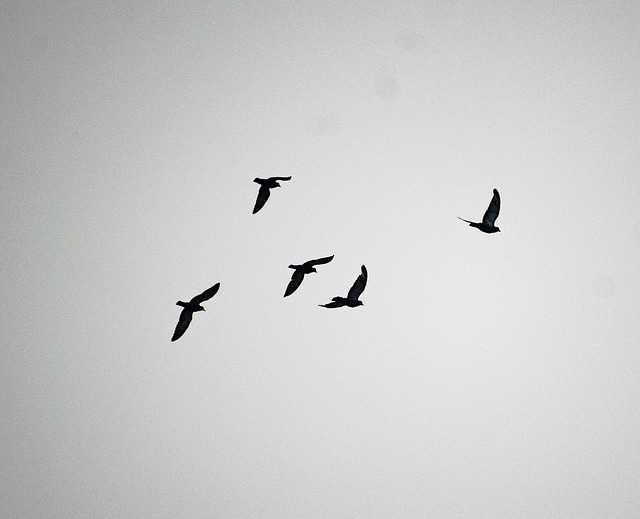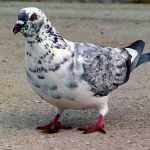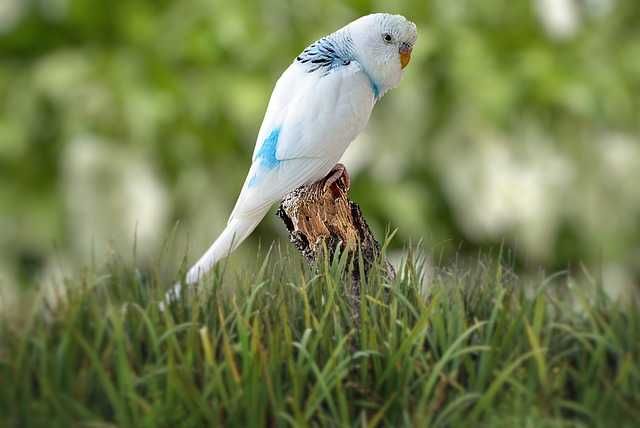Where do pigeons come from?
In the Book of life it is written,
They'll go to Paradise,
Those who have not sinned
And those who were saved.
There are many reasons why we can say that pigeons are peculiar birds. Probably, along with sparrows, pigeons are among the most famous species of wild birds in the world. The pigeon was essential in Darwin's studies, it maintained extraordinary cultural significance. Its role as a model organism spans the fields of behavior, genetics, and evolution. Archaeological evidence indicates that both Neanderthals and later Homo sapiens consumed rock pigeons for food. Mentions of pigeon breeding on artifacts from Mesopotamia and in Egyptian hieroglyphs indicate that we humans domesticated the species — for use as a food source — at least in 4,500 i.Hr. Animal mummies were common in Ancient Egypt and were used in religious ceremonies, often as offerings. Millions of mummified animals have been found, most dating back to around 600 î.Hr. up to 250 d.Hr. the ancient Egyptians believed in many gods and associated different animals with them. In ancient Egypt, birds used as votive offerings were prepared by gutting and drying, then soaked in molten resin and wrapped. However, sometimes the birds were not gutted, giving researchers a chance to take a look at a particular bird's life before it died. Only DNA analysis was able to conclusively determine how much hybridization occurred in a population, and many populations remain insufficiently studied. The original Pigeon is a species known as the rock pigeon, Columba livia and is part of the family Columbidae. Its closest relative is the similar-looking Hill pigeon Columba rupestris. The rock pigeon is the wild ancestor of the domestic pigeon, Columba livia domestica. Humans have kept and selected domestic pigeons for thousands of years, resulting in over 1,000 different breeds. Over the centuries, escaped domestic birds have added their eclectic genes back into the wild population, which is why wild pigeons come in a wide variety of colors. Some varieties have such bizarre plumage that they look just as similar to their wild ancestor.
The purest populations of rock pigeons exist where geographical barriers reduce hybridization. So wild pigeons are a hybrid between the original rock pigeon and domestic pigeons and are found everywhere in cities and the countryside, but not much is known about them. Wild pigeons have a distinctive and consistent pattern of feathers. They have pale gray triplets, two dark bands on the wings, and iridescent green and purple feathers along the neck and chest. They have orange eyes, pink legs and white ceres at the top of their beak. Males and females look very similar, except that females have less iridescence on the neck. Pigeons are the only birds that can suck water when they drink (the other birds must take water in their beak until they fill their mouths, then throw their head back so they can swallow it). Empirical studies support the idea that different spatially distributed ratios in the gradients of volatile organic compounds provide pigeons with information about the direction of travel. Pigeons have the ability to fly at altitudes above 1500 meters, and the maximum speed they reach is between 80 and 110 kilometers per hour. Both humans and pigeons learned matching, where a sample stimulus indicates which of the two stimuli matches the sample. Captured, moved and released pigeons fly back to their coops, even though they are hundreds of miles away from home. Called a" locating instinct, " this behavior allowed humans to use pigeons to steer sailors ashore and transmit messages over great distances. The use of messenger pigeons continued even into modern times, where birds were used in the first and Second World Wars to send messages from the front line and even to rescue stranded troops.
Wild pigeon populations are threatened by rooting with wild birds, and some ornithologists believe there are few, if any, true rock pigeon populations left. Therefore, domestic animals have been important culturally and economically throughout history. There is no conclusive evidence of the effectiveness of systemic macromutations or an explanation of the irreversibility of morphophysiological complications in pigeons. Even the theory of dotted equilibrium has not yet provided answers to these questions. The morphological characteristics and size of individuals change with allometric changes. Many of their ancestral lineages are extinct or genetically threatened following hybridization with domesticated relatives. Consequently, they have been insufficiently studied compared to the ancestral lines of domestic plants.
We dedicate this article in memory of our pigeons Cai Lun, Nei Gong and the family of Jupiter, who knew Titilica. Thank you and forgive us!

In memory of Zhuge
Wisdom is the best treasure. It shines and never goes out. It seeks out those who are worthy of it and guides them to the joy of immortality.
Wisdom differs from intelligence in that the former is a quality acquired during life, while the latter is innate. Intelligence can also be put at the service of evil, which is not the case with wisdom.
Numerous thinkers have tried to define this notion of ethics in a synthetic way. Diderot says that " wisdom is nothing but the science of happiness’, and .EINSTEIN shows that it is not the product of schooling, but of trying for a lifetime to get it’.It is the fruit of toil and pain.
More and more thinkers have come to the conclusion that this category of ethics has two components:’ wisdom as a divine gift’and "wisdom as a life experience". The first, truly superior, is the wealth of our whole being, because it is given without any payment and without any effort that man cannot make. This gift is the result of seeking, conquering, and praying with sincere love to God. Wisdom is not given to anyone, but only to those who want to find it or want to receive it.
Among the writings with religious - moral value, a special place is occupied by The’ Book of Proverbs’ whose key word is’wisdom " or "the ability to live life wisely and skillfully".Proverbs provide a God's detailed guidance for those who belong to him to know how to successfully face the practical problems of everyday life, how to get along with parents, children, peers, how to respect authorities, and many other aspects of life.
Solomon uses a combination of poetry, such as parables, maxims, questions with meaning and short stories to put into a memorable form, common sense and the divine perspective necessary for life. He collected about 3,000 proverbs, with the source being the near and Middle East. They are the product of his wisdom, considering that he lived 500 years before the Seven Sages of Greece and 700 years before the time of Socrates, Plato or Aristotle.
It is said that old people have this quality acquired from experience gained over the years. That is why the expression remained valid:’he who has no elders shall buy them". In history it is remembered the "counsel of the elders" who had a particularly important role in the life of the community for decision-making. Proverbs and sayings, but also our folk tales carry in their content the meaning of wisdom.
We dedicate this article in memory of our pigeon Zhuge. He got this name because if we humans can learn tasks explicitly, because we can often describe the rules we used to learn the task, he taught tasks purely associatively. Mr. Zhuge gradually learned the correlation between stimulus (or response) and result, often bringing smiles to the faces of those who knew him.
Thank you for everything Zhuge and forgive us for being powerless!

The parakeet Zhu Hua
In Qur'an, S. XXVII, vv. 15-16, it is mentioned that king David and king Solomon received knowledge from God as a gift. As part of this knowledge, David and Solomon were also taught the language of birds.
On the first qur'anic verses, namely the verses of Manteq at-Tair or the conference of the birds, Farid-ud-din Attar (CA 1120-1220 ad), is founded the medieval Sufi tradition within which Solomon is described as a connoisseur of the language of birds.
The Sufi Magister, the Sufi saint define themselves in relation to the human ideal or the mystical - gnoseological archetype embodied by Solomon, as connoisseurs of the language of birds, known in that time by Solomon. Jalal-ud-din Rumi (1207-1273 ad)
Rumi constructs the pedagogical model of mirroring, through the allegorical correspondence between man and bird.
A parrot sitting in front of a mirror, a man sitting behind a mirror. When the Invisible Man Speaks, the parrot looks in the mirror and has the illusion that he himself owns human language, although in reality he has only the power to imitate sounds, without understanding the meaning of words.
Similarly, God places shaykh as a mirror in front of the disciple, and he has the illusion that only the shaykh, the man, speaks to him, without understanding that the teaching, the knowledge he receives, has its origin in the universal reason behind the mirror, beyond the being of the shaykh: "the selfish disciple sees himself in the mirror of the body of the shaykh. How could he see universal reason, beyond the mirror, at the moment of manifestation of language and discourse? He assumes that a man is the one who speaks. Universal reason remains to him a mystery which he ignores."
That is why throughout history, parrots have been part of human culture. They are mentioned in mythology, art, literature and folk tales from different parts of the world. In some cultures, parrots are considered symbols of wisdom or spiritual messengers.
Parakeets are one of the most common domestic pet birds to have at home, for their beauty, how relaxing their song is and how easy it is to care for them.
So the parakeet is a little bird with a lot of history with the human being.
Parakeets develop strong bonds with their masters and become extremely affectionate. This strong bond contributes to the emotional well-being of both parties.
The loss of Zhu Hua, a member of our group of parakeets, has deeply affected both us who cared for him and the emotional health of Titilica and the entire community of loved ones who knew him.
Thank you Zhu Hua for your simplicity and naturalness, for these are the true signs of distinction. Forgive us!

biochem eng




